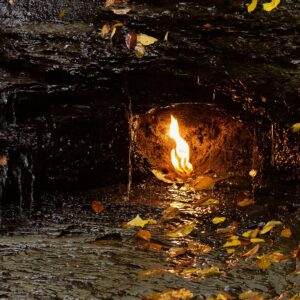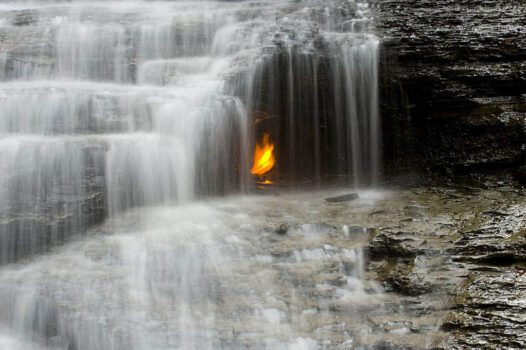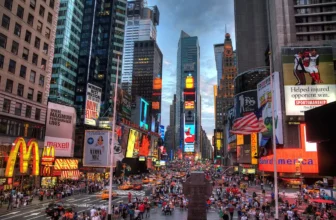A Timeless Mystery of Nature and Humanity
In a tranquil forest in western Pennsylvania, a small flame flickers behind a gentle waterfall. It is not powered by candles or lamps. No human tends to it. No fuel canisters rest beneath it. And yet it burns , endlessly, stubbornly, against the cascading water and over time’s relentless march.
This is one of Earth’s eternal flames , enigmatic fires that seem to defy logic, reason, and the laws of physics. They burn without an obvious fuel source, appearing to be powered by nothing more than the will of the universe itself.
But what is an eternal flame really? How does it keep burning when everything we know about fire says it shouldn’t? Can it ever go out? And perhaps the most tantalizing question of all: Why does it burn in the first place?
What Is the Flame That Burns Forever?

Eternal Flame Falls
An eternal flame is a flame that is meant to burn continuously for an indefinite period of time. In many cases, it’s symbolic , like the one at the Tomb of the Unknown Soldier in Arlington, Virginia, or the flame that burns in Hiroshima Peace Memorial Park. These flames are carefully maintained, constantly supplied with fuel, and monitored to ensure they never go out.
But the flames that most capture the imagination are not those tended by human hands. Instead, it’s the natural eternal flames , flames that seem to emerge spontaneously from the earth and burn ceaselessly, sometimes for centuries.
One such natural eternal flame lies within Chestnut Ridge Park in New York, glowing faintly from a rock crevice behind a small waterfall. Another burns in the mountains of Iraq, known to locals as the “Fire Mountain” or Baba Gurgur, whose flames have reportedly danced since before the birth of Christ.
These natural eternal flames are rare, but they’re real. And they force us to confront an almost mystical paradox: how can fire exist without firewood, oil, or any visible fuel at all?
Why Are the Eternal Flames a Mystery?
Fire, as we’re taught in basic science, requires three elements: fuel, heat, and oxygen. Take away any one of these, and the fire dies.
But many of the world’s eternal flames seem to lack at least one of these key components , especially the fuel. In places like Chestnut Ridge, no burning logs lie beneath the fire. No charred remains of organic material litter the ground. Yet the flame persists, quietly but determinedly licking the rocks.
Scientists initially assumed that these flames must be fueled by natural gas seepages , typically methane. In theory, underground pockets of gas bubble to the surface and ignite, either naturally (from lightning or friction) or by a human source. Once lit, the gas continues to rise and feed the flame.
However, the mystery deepens when one considers the composition of the gases. In the case of the Chestnut Ridge flame, geochemical studies revealed that the surrounding shale , the likely source of the gas , was not hot enough to produce thermogenic methane in the traditional way. Yet methane was present. This suggests a process of abiogenic methane formation , a poorly understood chemical reaction that can occur deep within the Earth, possibly involving water, minerals, and heat without the decomposition of organic material.
This process, if confirmed, would not only explain the eternal flames , it would revolutionize our understanding of Earth’s geology and even the origins of life.
How Does the Eternal Flame Keep Burning?
The mechanism that allows these flames to burn involves a delicate balance of natural processes:
Natural Gas Seepage: The most accepted explanation is that eternal flames are fed by slow, continuous seeps of natural gas from deep underground. These seeps may be imperceptible, invisible, and odorless, but they’re sufficient to sustain a flame once lit.
Porous Rock and Fault Lines: In many eternal flame locations, the surrounding geology includes porous sedimentary rocks like shale or limestone, which can trap and channel gas upward. Fault lines or fractures provide a path for gas to escape to the surface.
Ignition Source: The original spark may have come from a lightning strike, volcanic activity, or even human intervention in ancient times. Once ignited, the flame continues to burn so long as the gas continues to flow.
Sustained Conditions: The environment around many eternal flames helps protect them. In some places, overhanging rocks, caves, or water features create a kind of natural shelter that shields the flame from wind and rain.
In short, an eternal flame keeps burning because nature provides an uninterrupted supply of gaseous fuel, and the conditions are just right to prevent it from being snuffed out.
Has the Eternal Flame Ever Been Extinguished?
Despite their mythical reputation, yes , eternal flames can and have gone out.
Sometimes it’s due to human error. In 2013, the eternal flame at the John F. Kennedy gravesite in Arlington Cemetery temporarily went out during maintenance. A backup flame was used to relight it quickly.
Natural eternal flames are even more vulnerable. Though they may seem otherworldly, they are subject to the same earthly limitations as any fire. If the gas supply is interrupted , perhaps due to a seismic shift or blockage underground , the flame will die. Likewise, a strong gust of wind or heavy rainfall could extinguish it if the flame isn’t well-protected.
There have been reports of the Chestnut Ridge flame going out on occasion, only to be relit by hikers or locals who see it as a cultural and natural treasure.
So while “eternal” may be poetic, it is not absolute. These flames endure not because they are invincible, but because they are miraculously, precariously balanced.
Can the Eternal Flame Go Out?
Absolutely. Eternal flames are not immune to the laws of nature. They can go out if:
The gas supply is disrupted due to geological changes or depletion.
External forces like wind, water, or snow smother the flame.
Human interference tampers with the site.
In fact, the idea of an “eternal” flame is more of a symbolic aspiration than a physical certainty. Eternal flames represent endurance, memory, and the continuity of spirit. But in the natural world, they are vulnerable phenomena , persistent, yes, but not imperishable.
That said, their very persistence over years, decades, or centuries is still astonishing. Some, like Baba Gurgur, have been recorded as burning for over 4,000 years.
What Happens to the Eternal Flame When It Rains?
It’s a fascinating image: a flame quietly burning behind a waterfall or during a storm. So how does it survive?
Here’s how:
Sheltered Location: Many natural eternal flames are located in areas where water can’t directly douse the flame. For example, the Chestnut Ridge flame sits inside a small alcove beneath a rocky overhang, protected from direct contact with water. Even though it appears to burn “under” the waterfall, it’s actually in a shallow cave beside it.
Persistent Heat Source: As long as the flame’s temperature stays above the ignition point of the gas, it can re-ignite itself if briefly extinguished by rain. That means even if a drop of water temporarily puts it out, the continuous gas flow and residual heat can bring it back.
Low Wind Exposure: Rain is often accompanied by wind, which can be more dangerous to a flame than the water itself. However, the natural topography around eternal flames often provides windbreaks, helping the flame stay lit during storms.
In essence, nature seems to conspire to protect these flames, cocooning them in exactly the kind of environment they need to defy the elements.
How Long Do Eternal Flames Last?
The lifespan of an eternal flame depends on one crucial factor: the supply of fuel.
In the case of man-made eternal flames, such as those commemorating fallen soldiers or historic tragedies, the flames can last indefinitely , as long as someone refuels them. These are maintained through gas lines or other artificial means.
But natural eternal flames will only burn as long as:
The gas continues to seep upward.
The geological formations remain intact.
The external environment doesn’t extinguish them.
Some of these flames have lasted for centuries , the Baba Gurgur flame in Iraq may be the oldest known natural eternal flame, with a history stretching back millennia. Others, like those in New York or Turkey, may be newer or intermittently burning for decades.
But none are truly eternal in the cosmic sense. They are, at best, long-lived anomalies , reminders of the dynamic forces simmering beneath the Earth’s crust.
Eternal Flames in Mythology and Culture
Throughout history, humans have been drawn to flames that never die. Ancient civilizations revered them as sacred symbols of divine presence, protection, or remembrance.
Zoroastrianism, one of the world’s oldest monotheistic religions, centered around temples of fire, where an eternal flame represented divine wisdom and truth.
The ancient Olympic Games honored the Greek god Prometheus, who stole fire from the gods and gave it to mankind. An eternal flame was kept burning in his honor, a tradition that continues in modern Olympic ceremonies.
Christianity, Hinduism, Buddhism, and Islam all include flame or light as metaphors for divine knowledge, eternal life, and spiritual enlightenment.
It’s no coincidence that humans have chosen flames to symbolize that which should never be forgotten. A flame is alive, ever-changing, yet persistent , a fitting mirror of memory and soul.
A Flame Beyond Fire
The eternal flames that burn without fuel are more than just geological curiosities. They are mysteries that challenge our assumptions, blend science with myth, and ignite something primal within us.
Whether nestled behind waterfalls or roaring atop sacred hills, these flames serve as natural shrines , reminders that Earth still holds secrets we don’t fully understand. They are eternal only in their defiance of time, in the awe they inspire, and in the questions they keep asking long after the firelight dims.
Perhaps, in the end, the flame that burns forever is not just the fire on the rock , but the curiosity and wonder it sparks within us.
image/Mpmajewski/Vsevolod.oparin




